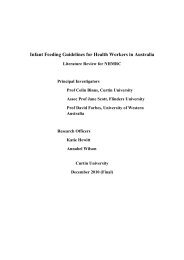ABDOMINAL PAIN, CHRONIC - Flourish Paediatrics
ABDOMINAL PAIN, CHRONIC - Flourish Paediatrics
ABDOMINAL PAIN, CHRONIC - Flourish Paediatrics
Create successful ePaper yourself
Turn your PDF publications into a flip-book with our unique Google optimized e-Paper software.
Starship Children’s Health Clinical GuidelineNote: The electronic version of this guideline is the version currently in use. Any printed version cannot be assumed to be current. Please remember to read our disclaimer.<strong>ABDOMINAL</strong> <strong>PAIN</strong>, <strong>CHRONIC</strong>It is not surprising therefore that the most useful approach is a biopsychosocial one where therecurrent abdominal pain is viewed as the child’s response to biological factors, influenced bytemperament (the child’s developing personality) and reinforced by the family and schoolenvironment.Clinical AssessmentThe logical approach to the child with chronic abdominal pain is a detailed history and physicalexamination.With encouragement even young children are able to indicate by pointing with one finger the site ofmaximal intensity of the pain. John Apley (the paediatrician who first described this syndrome)observed that the further the pain from the umbilicus , the greater the likelihood of organicdisease. Children often have difficulty describing the character of the pain but are usually able todescribe any radiation. Night-waking suggests peptic ulcer disease as does pain that isaggravated by meals .The latter may also be a symptom of gastro-oesophageal reflux particularlywhen associated with vomiting. It is important to obtain a detailed history of the frequency andcharacter of the child’s bowel motions. Older children are often embarrassed to discuss their bowelmotions and it may be necessary to keep a diary. Blood in the bowel motions, fever, weight loss,arthritis and skin rashes are indicators of chronic inflammatory bowel disease.If the child’s diet contains excessive amounts of lactose or sorbitol (as an artificial sweetener)restricting these should result in an improvement in symptoms if their malabsorption is responsiblefor pain and flatulence.Drugs that produce abdominal pain include tetracyclines (oesophagitis) and non-steroidal antiinflammatoryagents (gastritis).Specific enquiry should be made for a family history of irritable bowel syndrome, peptic ulcer,coeliac and inflammatory bowel disease.The best way to assess the severity of the pain is to find out how much it interferes with the child’sdaily activities.In younger children chronic abdominal pain may be a manifestation of separation anxiety. Witholder children and adolescents, time should always be taken to interview the patient alone. Duringthis interview concerns regarding the cause of the pain are explored and stressors in the home andschool environments are discussed. Parental conflict, concerns regarding academic achievement,peer relationships, substance abuse, and sexuality are all potential areas of concern for olderchildren and adolescents. The possibility that the child or adolescent is depressed should alwaysbe considered.It is always helpful to ask the parents and the child what they think may be causing the abdominalpain .It is not uncommon for them to be worried that the pain might be due to a serious diseasee.g. leukaemia which can easily be excluded on clinical assessment and a blood count.Physical examination must include an assessment of growth and general nutrition. A completephysical examination may detect other clues to underlying disease processes (e.g. clubbing inchronic inflammatory bowel disease) and always provides reassurance to the child and family thattheir concerns are being taken seriously. Abdominal examination focuses on areas of tenderness,Author: Dr Ralph Pinnock Service: General <strong>Paediatrics</strong>Editor: Dr Raewyn Gavin Date Reviewed: August 2008Abdominal Pain, Recurrent in Childhood Page: 2 of 7









